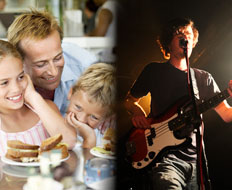Q: My location is across the highway from a major amusement park that closes November to May every year. We've built a successful year-round business with our bar and live music stage. How do I brand a "rock bar and restaurant" business that's edgy enough to support a live music crowd and mainstream enough for families visiting the amusement park?
A: You certainly have a marketing challenge there, Jeff. Appealing to two very different target audiences can be such a challenge, normally I recommend against it. But I understand your unique situation requires it.
You have two options: craft an overarching brand platform that works for both audiences and tailor messaging to each, or use a linked brand to create separate brand identities for each part of your business.
For the first option, you would need to select a brand platform that is elastic enough to stretch across both types of experiences you offer. You might think about the elements they have in common—say, food fresh off the grill and a down-to-earth personality—and associate your brand with those broader ideas.
Tailor the messaging of that overarching brand idea and your marketing strategy to the individual audiences. You should emphasize the aspects of the brand that are most relevant to each audience and talk about the benefits that are most meaningful to each. But the messages for each group need to support or at least fit under the overall brand platform. Signage and all in-restaurant materials should also communicate the overarching brand, so you should establish one look and feel and use it across everything.
This approach is best if you have limited resources to invest in marketing, but it may water down your brand since using one idea to appeal to two audiences usually requires a more generic proposition.
The other option is to create a second brand to distinguish between the two experiences. Just as Disney created the Touchstone label for its R-rated movies that didn’t align with Disney’s wholesome “family entertainment” image, you might create a distinct brand for your “rock bar and restaurant” experience. This should establish enough distance from your core family business to reduce the brand associations that seem to conflict or detract from each other.
I wouldn’t recommend going so far as to create a completely separate brand, since that might suggest that you offer two separate experiences, which you don’t since you’re in a single, shared location and have one menu and staff. Plus, I’m assuming you already have established a good level of brand awareness among the live-music target audience and want to build on that.
A sub-brand or endorsed brand makes sense. For example, Hallmark created Shoebox and endorsed it by using the descriptor “A tiny little division of Hallmark.” It wanted to designate the irreverent, edgy humor of Shoebox greeting cards as different from the Hallmark brand, but it also wanted to leverage the awareness and equity of the Hallmark brand. Two product lines, two personalities, two target audiences—different but related.
In Las Vegas, the Shops at Caesars use a linked brand approach for the collection of stores attached to Caesars Palace. Not only does the name lend some cachet to the mall, it also specifies the location. This may be relevant to your business, if locals already know where you’re located. You might consider a name like “The Rockin’ Stage at H&H Grill.”
To designate your live-music business with a linked brand, you need to develop a separate brand identity and positioning to clarify what makes that experience different from your core business. Use a distinct look and feel to express that difference, and add signage and in-restaurant materials to promote the brand separately.
Of course, this option requires a greater investment, but it yields important benefits. It communicates legitimacy by telling people this isn’t just something you’re doing on the side, it aids memory by providing a mental handle to help people remember it, and it helps communication by giving people something to call it so they can tell others about it easily.
By the way, a linked brand can be useful in other situations. It can help promote a new daypart (think Taco Bell’s Fourthmeal), a value-added service (Genius Bar at Apple retail stores), or an exclusive experience (Chef’s Table at Brooklyn Fare).
Regardless of the option you select, your marketing programs should use different channels and tactics to reach the different audiences. Co-marketing programs with nearby hotels and distributing coupons through the amusement park might be the best ways to reach the families, while ads on local radio stations and in local newspapers might be most effective for getting to the live-music crowd. Consider doing a local search campaign and create separate landing pages for each audience.
Just remember, your marketing to one audience should not be alienating to the other. Different is OK; offensive isn’t.
You’re fortunate to have two growth avenues, Jeff. You can nurture both with either of the above options.










